Note: If an image ever fails to appear - refresh your page, it really is there
The Historical Flags of Germany Part 1
To understand German thinking of this period one must first understand that they looked back to the Frankish King, Karl the Great (Charlemagne), and his "Holy Roman Empire," which lasted from 800 to 925, as the first great Deutsches Reich (German Empire). In 962, Karl's grandson, Otto I of Germany was re-crowned "Emperor of the Romans" by Pope John XII, thus giving the German kings once again claim to the title "Holy Roman Emperor." From this time forward, the German kings would continually claim the right to rule this central European empire.
| Top of the page | The Holy Roman Empire | Prussian Flags Before 1800 | Prussian Flags 1800-1892 |
| Prussian Flags After 1900 | Imperial Germany Era Flags | German Colonial Flags | Weimar Republic Era Flags |
| Third Reich Era Civil and Political Flags | Third Reich Era Military Flags | Modern Era Flags |
Flags of the Prussia - Before 1800
Among the groups of knights organized during the Crusades (e.g Templars, Hospitallers) was a group, largely German, called the Deutscher Orden (German Order), or Teutonic Knights. In 1225, after the failure to reconquer the Holy Land, Pope Gregory IX ordered the Teutonic Knights to convert the Prussians, a people related to the Lithuanians and Latvians, and who were the last remaining pagans in Europe. This historic event would start Prussia on the road to empire and the process of forming a new Germanic empire. By 1701, Prussia became a kingdom and from then until 1871, it was in a continuous stage of expansion until it came to be by far the largest German state, almost as large as all the others together, and the neclus of the Second Reich.

Teutonic Knights
|
Teutonic Order Banner
Turning loose the Teutonic Knights on the Prussians apparently pleased the Poles, especially their ruler the Duke of Mazovia, to whom the Prussians were not only non-believers, but also warlike pains-in-the-neck. In a long war the Order finally conquered the Prussians by 1285, killing some, converting and subjecting others, and set up a unique feudal state (called the Ordenstaat) which lasted until their Grand Master Albert of Brandenburg-Ansbach converted to Lutheranism and turned the lands of the order into the secular Lutheran Duchy of Prussia in 1525.
Their symbol was a Black Scandinavian Cross on a white field. Occasionally, the flag is shown with a narrow blue stripe along the hoist, and more often with the fly split into three tails, as shown below on the Grand Master's banner.
|

Teutonic Grand Master
|
Teutonic Order Grand Master's Banner
The Grand Master (Hochmeister) of the Teutonic Order was the supreme leader of this powerful military order, originally started in Acre during the Crusades. It is an elected office, but one held for life. The Teutonic Order actually still exists today and is still led by a grand master, although the organization has changed into a clerical Roman Catholic religious order.
In the beginning, candidates for Grand Master were usually chosen on merit, were experienced senior administrators of the order, before their election. The Grand Masters were the most powerful after the order's 13th Century conquest of Prussia during the Northern Crusades. They created the militarized State of the Teutonic Order (Ordenstaat), which lasted until 1525. A steady power decline in the order began when the control fell to the powerful Wettin and Hohenzollern dynasties and resulted in its conversion into the secular Duchy of Prussia. |
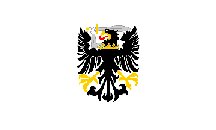
Royal Prussia
|
Royal Prussia 1466-1772
After the Battle of Tannenberg in 1410, the Treaty of 1466 gave the King of Poland most of the Teutonic Order's territory west of the Vistula. This became Royal Prussia, and the rest of Prussia in 1525 became the Grand Duchy of Prussia after the Grand Master, Albrecht von Brandenburg, secularized the Teutonic Order, making the Duchy a fief of Poland.
Shortly after the Grand Duchy of Prussia was inherited by the Elector of Brandenburg, one of the princes entitled to elect the Holy Roman Emperor. (see below)
|
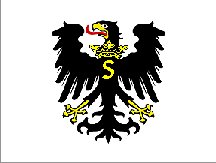
Duchy of Prussia
|
Grand Duchy of Prussia 1525-1657
In 1466, the state of the Teutonic Order (that part of Prussia not under Polish sovereignty as Royal Prussia) became a Polish vassal. In 1525, with the secularisation of the Teutonic Order, the Grand Duchy of Prussia (Ducal Prussia) was established as a Polish vassal. In 1525, the Polish King Zygmunt Stary (Sigismund the Older) gave Ducal Prussia a flag and a coat of arms: a black eagle with a crown on its neck and the letter S (Sigismund) on its breast. Ducal Prussia was a Polish vassal until 1657.
When in 1660, the Duchy of Prussia became independent of Poland the way was opened to unite with Brandenburg and and eventually the Prussian state.
|
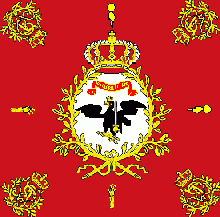
Regimental Standard
(unidentified Prussian regiment)
|
Hohenzollern Regimental Standards
Hohenzollern Castle (Baden-Württemberg) was the ancestral home of the counts of Zollern (later known as the Counts of Hohenzollern), who became the electors of Brandenburg. After the Riots of 1848, Hohenzollern became part of the Kingdom of Prussia, and its rulers went on to eventually become the Kaisers of the (2nd) German Empire.
This red standard, with its black eagle in a white disc at its center and is one of several displayed at Hohenzollern Castle. This design is the usual pattern used on all Prussian regimental standards, of which there are hundreds with various background colors and shield designs. On this one, golden laurels surround the disc, and the eagle is crowned and armed, holding a sword in one claw and a bundle of lightning bolts the other. Above the eagle in the disc is a red ribbon with the golden motto "Pro Gloria Et Patria" (for fame and fatherland) written on it. In each corner is the golden crown atop a wreath of laurels surrounding the letters "FWR" standing for King Fredrick William (Friedrich Wilhelm, Rex).
Fredrick William was the first Hohenzollern allowed to use the title of "King of Prussia," and it became traditional to include his "King´s Sign" on most Prussian regimental standards. The little "flaming cannon balls" were also a common design element. Learn More at: Prussian Infantry Regimental Colours.
|
| Top of the page | The Holy Roman Empire | Prussian Flags Before 1800 | Prussian Flags 1800-1892 |
| Prussian Flags After 1900 | Imperial Germany Era Flags | German Colonial Flags | Weimar Republic Era Flags |
| Third Reich Era Civil and Political Flags | Third Reich Era Military Flags | Modern Era Flags |
Flags of the Prussia 1800-1892
At the end of the Napoleonic wars, a paranoid Imperial Russia and an aging Hapsburg-dominated Austria and Hungary made sure they were protected from any future French menace by placing 38 small Germanic buffer states between France and themselves at the Congress of Vienna in 1816. While this reassuring Russia and Austria, it made the small German buffer states a bit nervous, and this combined with the dreams of a second Reich, led to a slow, but sure process of unification within what eventually became known as the "Confederation of the Rhine" under the leadership of Brandenburg/Prussia.
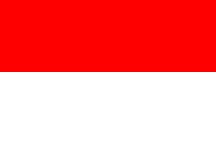
Province of Posen 1849
|
Grand Duchy of Posen 1815-1849
Posen Province 1849-1886 (Prussia, Germany)
The Grand Duchy of Poznan (Posen) was part of the Kingdom of Prussia, created from territories annexed by Prussia after the Partitions of the Polish-Lithuanian Commonwealth, and formally established following the Napoleonic Wars in 1815. Per agreements derived at the Congress of Vienna it was to have some autonomy. However in reality it was subordinated to Prussia and the proclaimed rights for Polish subjects were not fully implemented. The name was unofficially used afterward for denoting the territory, especially by Poles, and today is used by modern historians to describe different political entities until 1918. Its capital was Posen (Poznan). The Grand Duchy was formally replaced by the Province of Posen in the Prussian constitution of 1848.
|

Province of Posen 1886
|
Posen Province 1886-1920
In 1886, the flag was changed by the Prussian authorities into horizontal white-black-white triband, because the former was far too similar to Polish. The White-black-white triband was the official provincial flag until 1918.
|
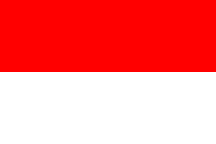
Flag of Brandenburg
|
The Brandenburg Province Flag (East Prussia) 1882-1935
This red and white horizontal striped bicolor flag was officially adopted in 1882. Brandenburg's capital was originally Potsdam, before moving to Berlin in 1827. Following German reunification in 1990, Brandenburg was re-established as a state of the Federal Republic of Germany.
|
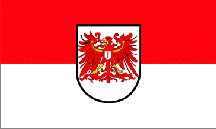
Brandenburg State Flag
|
The Brandenburg Province State Flag (East Prussia)
The ruling family of Brandenburg (East Prussia) were the Hohenzollerns. They united both East and West Prussia, and eventually became the ruling family of Imperial Germany. They also used the plain red and white striped flag without the shield shown above.
|

East Prussia Flag
|
The East Prussia Flag 1882-1935
This black and white horizontal striped Bicolor flag was officially adopted October 22, 1882, and abolished in 1935 by Adolf Hitler and the Third Reich. |
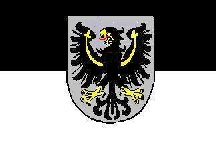
East Prussia State Flag
|
The East Prussia State Flag
In 1701, the Elector Frederick III of Brandenburg began using the title "King in Prussia." East Prussia was later joined with West Prussia to become the Kingdom of Prussia. East Prussia is now located in the modern country of Poland. Besides this flag they also used the plain black and white striped flag without the shield shown above. |

West Prussia Flag
|
The West Prussia Province Flag 1886-1920
This black/white/black horizontal striped Tricolor flag was officially adopted November 9, 1886, and abolished in 1920 when it became part of the Posen-West Prussia Frontier Province (1920-1935). |
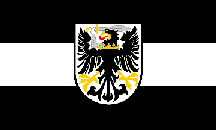
West Prussia State Flag
|
The West Prussia State Flag
West Prussia was separated from Brandenburg by a part of Poland and bordered the Baltic Sea. She joined with East Prussia to become the Kingdom of Prussia. West Prussia is now located in the modern country of Germany and is known as the State of Brandenburg. They also used the plain black/white/black striped flag without the shield shown above.
|
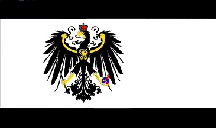
Kingdom of Prussia Flag
|
The Kingdom of Prussia Flag 1701-1918
The Kingdom of Prussian eventually became the North German Federation between 1867 and 1871. Under the leadership of Kaiser Wilhelm II and Otto von Bismarck they formed Imperial Germany or the Second Reich (Second Empire).
|
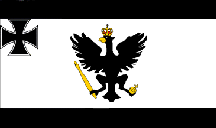
Prussian War Ensign 1862
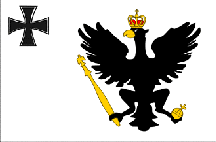
Prussian Civil Ensign 1817
|
Prussian War and Civil Ensigns 1818-1863
The first Prussian warship was built in 1816 (the Stralsund) and it needed an ensign.
Kaiser Wilhelm chose a design of a black eagle in heraldic form, on a white background charged in the canton with the iron cross. This ensign was first used in the spring of 1817 and appeared both as a traditional rectangular-shaped flag and as a swallow-tailed flag. During this early period, several slightly different interpretations of the eagle were used, but after 1863, the ensigns were mainly used in their rectangular form without swallow-tails. The final design was confirmed in 1850, and the swallow-tailed war ensign disappeared from the open seas by 1867. After 1871, when Prussia became Imperial Germany, this ensign's use was restricted to internal waters only.
 |
|
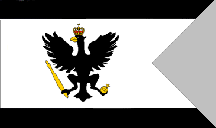 |
| Prussian War Ensign 1818 |
|
Prussian War Ensign 1823 |
These flags without the Iron Cross acted as the "Prussian Civil or Merchant Ensign" and the Prussian government allowed ship owners and sailors to add the name of their own town or province on the white stripe when used as a merchant ensign. Between 1892-1918 these flags were also known as the "Imperial Inland Waters Ensign," and used an eagle design based on the shield of the Imperial German War Ensign.
|
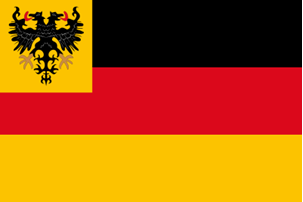
Reich Fleet Flag
|
War Ensign of the Reichsflotte 1848-1852
The Reichsflotte (Reich Fleet) was the first all-German Navy. It was founded in 1848 during the Revolutions of 1848 in the German states by the Frankfurt Parliament to provide a naval force in the First Schleswig War against Denmark.
The War Ensign displayed the Eagle of the German Confederation in the canton and was used until 1852. Great Britain never accepted this German War Ensign; rather ships that flew the flag were treated as pirates. |
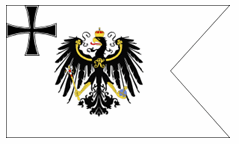
War Flag of Prussia until 1867
Top Mast Flag of SMS "Prussia"
Weimar Republic 1919-1935
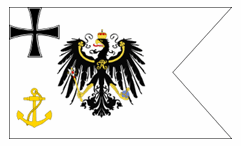
Inland Waters General Services
The eagle used on these interesting flags were based on the shield design used on the old national flag of the Kingdom of Prussia and also were used on the Imperial German War Ensign. |
Prussian Inland Waterways Ensigns 1867-1918
The Inland Waters General Services Ensign was the general Imperial Service Flag for all Prussian Inland Waterways. This service was responsible for the monitoring, regulation, and control of all inland shipping, such as the transport of bulk goods (ore, coal, etc.), on the important Prussian waterway system.
The Inland Waters Customs Service Ensign was the Prussian Service Flag for Inland Waterways used by the Customs Service. The Customs Service was the agency in Prussian Germany responsible for collecting and safeguarding of customs duties and for controlling the flow of goods including animals, personal effects and hazardous items in the inland waterways.
The Inland Waters Fishery Service Ensign was the Prussian Service Flag for Inland Waterways used by the Fishery Supervision Service. This service was responsible for the stewardship of the German fishing industry and other inland marine resources, including the monitoring, regulation, and control of commericial and sports fishing on the Prussian German waterway system, much like any modern Wildlife Service.
|
|
|
Inland Waters Customs Service |
|
Inland Waters Fishery Service |
|
| Top of the page | The Holy Roman Empire | Prussian Flags Before 1800 | Prussian Flags 1800-1892 |
| Prussian Flags After 1900 | Imperial Germany Era Flags | German Colonial Flags | Weimar Republic Era Flags |
| Third Reich Era Civil and Political Flags | Third Reich Era Military Flags | Modern Era Flags |
Flags of the Prussia Since 1900
During the beginning of the 20th Century Prussia was the heart of the Second Reich, and then with the defeat of Imperial Germany, a part of the Weimar Republic, until the rise of the Third Reich. Since the end of World War II the lands of Prussia have been divided between Poland and Germany. Germany itself was divided into East and West until 1992.
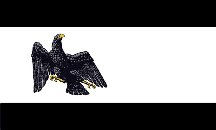
Free State of Prussia Flag
|
Free State of Prussia Flag 1918-1933
The Free State of Prussia (Freistaat Preussen) was a German state formed in the aftermath of World War I. It was the major state of Germany during the time of the Weimar Republic, comprising almost five-eighths of its territory and population. "Free State" is a German term for Republic. The democratic Free State of Prussia was taken over by coup in 1933 and its President Otto von Braun taken out of office. His government went to court over this ouster and after the end of war, Otto von Braun approached U.S. officials to reinstate the legal Prussian government. They and the other Allied Occupation forces, who had taken up occupation of all of Germany, were not interested and declared Prussia abolished in 1947.
As was the case after World War I, almost all of this territory had been Prussian territory and most of it went to Poland (the northern third of East Prussia, including Königsberg, now Kaliningrad was annexed by the Soviet Union). The losses represented nearly two fifths of the Prussian territory and nearly a quarter of territory within Germany's pre-1938 borders. An estimated ten million Germans fled or were expelled from these territories as part of the German exodus from Eastern Europe. See the "Territorial Association of East Prussia Banner" below. |

Posen/West Prussa Flag
|
The Posen/West Prussia Frontier Province Flag 1920-1935
In the last part of the 19th century, hundreds of small Germanic kingdoms, princedoms, duchies, margravates, etc., were finally united into the German Empire (Deutsches Reich). The more important units became Länder (states); others became Provinzen (provinces) within the states. At the end of World War I, the portions of Posen and West Prussia provinces remaining in Germany merged to form the Posen-West Prussia Frontier province (Provinz Grenzmark Posen-Westpreußen).
The flag was divided into three horizontal stripes and in half vertically. (horizontal stripes: first row: black-white, second row: white-black, third row: black-white). The flag was adopted in 1920 and abolished in 1935 by the Third Reich. |

Posen/East Prussia State Flag
|
The Posen/West Prussia Official State Flag
This design is of a possible administrative flag for the Posen-East Prussia Province between 1920-1935, with a coat of arms, consisting of a silver field with a black Prussian eagle; emerging from the neck is a silver arm with armor grasping a silver sword.
In 1938, under Hitler's Third Reich, the Posen-West Prussia Frontier province was split into parts, which merged with Brandenburg, Pomerania, and Silesia. |
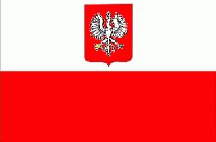
Republic of Ostrów Flag
|
Republic of Ostrów Flag 1918
The Ostrowska Republic (Republic of Ostrów), which only lasted between October 10, 1918, and November 26, 1918, was another short-lived republic that existed in the former Grand Duchy of Posen. About a month before the start of the Greater Poland Uprising (Powstanie Wielkopolskie), which would bring the whole area out of German hands and back into Poland in 1919, the citizens of the town of Ostrów Wielkopolski decided to liberate themselves from the Germans and declared themselves the independent
Ostrowska Republic. This flag, very obviously an ancester of the modern flag of Poland, did fly over an independent Republic of Ostrów for that very short period of time.
On October 10, 1918, the newly formed People's Committee of Ostrów issued
their declaration of independence to the Germans, but after a few sporadic skirmishes, the Committee decided it was in over its head, negotiated a few favorable concessions with the Germans, and then, dissolved itself on November 26, 1918. The Greater Poland Uprising started a month later in the town of Ostrów. |
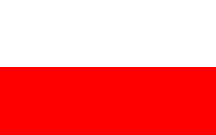
Modern Poland Flag
|
The Flag of Poland 1919
Prussia no longer exists as an independent state, but is split into two parts and incorporated into the modern countries of Germany and Poland. The Polish flag dates back to the pennants of the Middle Ages. At first they were all red with a white eagle, but by the 17th Century the background colors of red and white stripes were firmly established. The banners usually bore the official crest of the State. These Polish national colors were used during the November Uprising of 1831, and the colors were used in all national uprisings since that time. They were officially recognized as state colors in 1919 after Poland had regained her independence. |
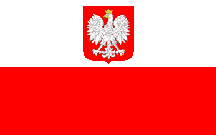
Poland State Flag
|
The Poland Official State Flag
Poland's "landesfarben," or land colors, derived from its coat-of-arms, are white-red; the opposite of the red-white of modern Brandenburg (West Prussia), which is now located in Germany. The State Flag of Poland, with the Polish coat-of-arms, has been in use since 1919. The flags only change came during Communist rule when the crown was removed from the head of the eagle. After Poland became independant the crown was returned. Interestingly, Poland doesn't have a king, but the crown remains. Some also claim the length of the eagle's claws having been changed.
|
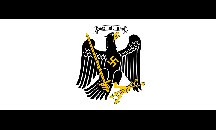
State of Prussia Flag 1933
|
Free State of Prussia Flag (under Nazi Germany) 1933-1935
Although this is an early Third Reich flag, it seemed better suited at this location since individual State flags virtually disappeared in Germany after 1935. This was the Flag of the Free State of Prussia during its brief existence in the Nazi era.
In 1933, the "Preussenschlag" (Prussian coup), Reich Chancellor Franz von Papen unseated the democratic Free State of Prussia government under Otto von Braun under the pretext that it had lost control of public order. This was triggered by a shootout between SA demonstrators and Communists in Altona, Hamburg. After this emergency decree, Papen appointed himself Reich Commissioner for Prussia and took control of the government. This made it easy for Adolf Hitler to assume control over Prussia in the following year.
|
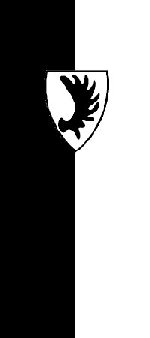
Landsmannschaft Ostpreussen
|
Territorial Association of East Prussia Banner - Since 1948
One of the results of the disappearence of the Free State of Prussia was the forming of the "Landsmannschaft Ostpreussen" (Territorial Association of East Prussia) as a non-profit organization for Germans who were evacuated or expelled from East Prussia during World War II and its aftermath. It was formed in 1948 by a group of East Prussian "vertriebene" (refugees) in West Germany. The Landsmannschaft of East Prussia flies a hanging flag (Banner) in the historical East Prussian colors of black and white. Instead of the historical coat-of-arms of East Prussia, they use the arms of the Landsmannschaft, an elk's antler.
The organization's current president is Wilhelm von Gottberg. Its seat is located in the City of Hamburg, and it is a member of the "Bund der Vertriebenen" (Union of the Displaced). Its official newspaper is the "Preussische Allgemeine Zeitung" (Prussian General Newspaper).
The "Bund Junges Ostpreussen" (Union of Young East Prussians) is a subsidiary youth organization of the Landsmannschaft; its predecessor, "Junge Landsmannschaft Ostdeutschland" (Cultural or Welfare Society of Young East Germans), was disassociated from the parent organization in 2000.
|
- My thanks to "Fornax" for all his expert help, research, advise, and images used on this page -
| Top of the page | The Holy Roman Empire | Prussian Flags Before 1800 | Prussian Flags 1800-1892 |
| Prussian Flags After 1900 | Imperial Germany Era Flags | German Colonial Flags | Weimar Republic Era Flags |
| Third Reich Era Civil and Political Flags | Third Reich Era Military Flags | Modern Era Flags |
|